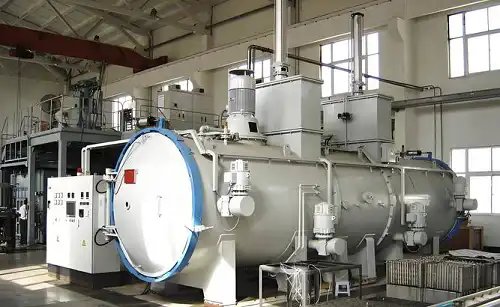
Knowledge
Research and Summary on the Heating Lag Time of Vacuum Furnace
I. Main Factors Affecting Heating Lag Time
1) Heating temperature
Principle: When the heating temperature rises, the thermal radiation efficiency of the component increases quadratically (radiation energy ∝ T⁴), the heating speed of the workpiece accelerates, and the lag time shortens.
Experimental support: When the heating temperature of 40CrMnSiMoVA steel is raised from 870℃ to 920℃, the lag time is significantly reduced, and high radiation energy accelerates the sintering process.
2) Heating Method
Preheating effect: By comparing the stepwise heating and direct heating during preheating, it is found that preheating can reduce the temperature difference between the workpiece and the furnace chamber, thereby minimizing the thermal stress and deformation risks during subsequent heating.
Applicable scenarios: Materials with poor thermal conductivity (such as stainless steel), steel grades with carbon content > 0.4% need preheating (650~700℃ or preheating with an additional 850~900℃);
Complex/with sharp corners workpieces, and workpieces with hardness > 35HRC need preheating to reduce the risk of cracking.
3) Furnace Loading Quantity and Loading Method
Size influence: Under the same material conditions, the lag time of the rod material with diameter φ50 mm is approximately 40% longer than that of φ35 mm. The longer heat conduction path of large-sized workpieces leads to a more significant lag.
Furnace loading density: Dense loading of the furnace will lead to thermal shielding. The outer ring workpieces will have better radiation absorption, while the central part will have a significant lag in temperature rise (heating time needs to be extended or the furnace loading arrangement needs to be changed).
II. Core Method for Determining Heating Lag Time
1) Measuring Method (Direct Tracking Thermocouple Method)
Operation: Fix a thermocouple on the surface or core of the workpiece for real-time temperature measurement, directly obtaining the temperature-time interval.
Applicable scenarios: Single-chamber vacuum furnaces (such as vacuum brazing, annealing), can precisely match the furnace exit timing to avoid over/under heating.
2) Simulation Method (Approach Based on Similar Conditions)
Steps: Select typical workpieces to establish heating models (such as different thicknesses/materials), and form a database reference after measuring their temperature rise curves.
Case: For a 40CrMnSiMoVA steel rod with a diameter of φ35~50 mm and a length of 150 mm, the single-piece heating curves vary significantly at 920℃. Key parameters need to be recorded layer by layer.
3) Empirical Method (Extending the Heating Time of Air Furnace)
Principle: The heat transfer efficiency in a vacuum furnace is lower than that in an air furnace. The lag time can be roughly estimated by multiplying the insulation time of the air furnace by 1.5.
Exceptional conditions: When the gas flow pressure is high (≥75 kPa), convective heat transfer is enhanced, and no additional time compensation is required.
III. Supplementary Notes on Heat Treatment after Vacuum Brazing
Temperature and time control: Taking 6061 aluminum alloy as an example, after solution treatment at 530℃ for 6 hours, combined with multi-stage aging (T6I6), the corrosion resistance can be enhanced (intergranular corrosion is transformed into uniform corrosion).
Vacuum and Humidity Requirements: High vacuum (≤ 10⁻³ Pa) can inhibit oxidation and loss of volatile elements; when humidity is greater than 50%, it is prone to cause the solder to hydrolyze and generate Al₂O₃ inclusions.
IV. Conclusion and Optimization Measures
1) Enhancement of Process Standardization
When loading the furnace for mixing, the holding time is determined based on the maximum effective thickness of the workpiece to avoid overburning of thin parts or incomplete burning of thick parts;
The preheating is quantified as 0.5 to 1 times the holding time, or adjusted through actual measurement.
2) Balance between efficiency and quality
For precision parts, it is recommended to conduct actual measurement and precise temperature control. For general parts, the simulation method can be adopted to enhance efficiency;
In cost-sensitive scenarios, the empirical method can be used for estimation (combined with risk warning).
3) Equipment Parameter Adaptation
The high-performance vacuum furnace with uniform temperature within ±3℃ is suitable for complex workpieces (such as heat dissipation strips). Combined with the material optimization of the radiation screen (such as polyacrylonitrile graphite felt with a thermal conductivity of 0.06 W/m·K), the thermal inertia is reduced.
Research Summary:The heating lag time is jointly determined by material properties, equipment's thermal transfer efficiency, and process parameters. It requires a combination of experimental and empirical methods for dynamic management to ensure process stability and the optimal economic benefits.
If you have any question, demand, related parts development or improve your supply chain, please feel free to contact us atinfo@castings-forging.com




